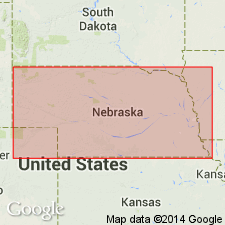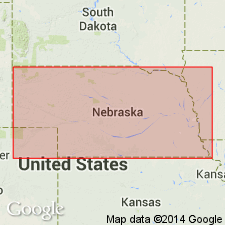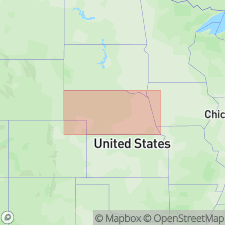
- Usage in publication:
-
- Morton limestone
- Modifications:
-
- Original reference
- Dominant lithology:
-
- Limestone
- AAPG geologic province:
-
- Nemaha anticline
Summary:
Pg. 41-42, 43. Morton limestone formation. Dark-gray to yellowish or brownish locally irregular sandy to conglomeratic fossiliferous limestone. Thickness about 2 feet. First limestone above Dover formation in Nebraska and lies between Minersville shale member of Friedrich formation and what seems to be the Dry shale. Included in Wabaunsee group. Age is Late Pennsylvanian (Virgilian).
Named from outcrops at Morton stockyards in south Table Creek Valley, southwest of Nebraska City, Otoe Co., southeastern NE.
Source: US geologic names lexicon (USGS Bull. 1200, p. 2609).

- Usage in publication:
-
- Morton limestone
- Modifications:
-
- Areal extent
- AAPG geologic province:
-
- Nemaha anticline
- Forest City basin
Summary:
Pg. 14-15. Morton limestone. Geographically extended into southwestern Iowa. Extends from near Thurman, southwestern IA, to northeastern KS but not as far as Kansas River Valley. Age is Late Pennsylvanian (Virgilian).
Source: US geologic names lexicon (USGS Bull. 1200, p. 2609).

- Usage in publication:
-
- Morton limestone
- Modifications:
-
- Overview
- AAPG geologic province:
-
- Nemaha anticline
Summary:
Pg. 43-44. Morton limestone formation [Condra and Reed, 1943]. Included in Wabaunsee group. At Nebraska City, [Otoe County], Nebraska, dark gray to yellowish or brownish, locally irregular, sandy to conglomerate, and quite fossiliferous, thickness 2 feet. Overlies Dry shale formation and underlies Minersville shale formation. South and southwest of Pawnee City, [Pawnee County], Nebraska, bluish-gray, dense, fossiliferous, thickness 1+/- feet. Overlies Dry shale formation and underlies Friedrich shale formation. Age is Late Pennsylvanian (Virgilian).
Source: Publication.
For more information, please contact Nancy Stamm, Geologic Names Committee Secretary.
Asterisk (*) indicates published by U.S. Geological Survey authors.
"No current usage" (†) implies that a name has been abandoned or has fallen into disuse. Former usage and, if known, replacement name given in parentheses ( ).
Slash (/) indicates name conflicts with nomenclatural guidelines (CSN, 1933; ACSN, 1961, 1970; NACSN, 1983, 2005, 2021). May be explained within brackets ([ ]).

